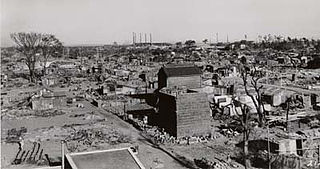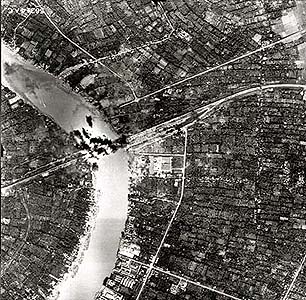During World War II, Operation San Antonio was the name used for a number of air attacks launched by United States Army Air Forces B-29s flying from bases on Guam to targets in the Tokyo area. [1]

World War II, also known as the Second World War, was a global war that lasted from 1939 to 1945. The vast majority of the world's countries—including all the great powers—eventually formed two opposing military alliances: the Allies and the Axis. A state of total war emerged, directly involving more than 100 million people from more than 30 countries. The major participants threw their entire economic, industrial, and scientific capabilities behind the war effort, blurring the distinction between civilian and military resources. World War II was the deadliest conflict in human history, marked by 70 to 85 million fatalities, most of whom were civilians in the Soviet Union and China. It included massacres, the genocide of the Holocaust, strategic bombing, premeditated death from starvation and disease, and the only use of nuclear weapons in war.

The United States Army Air Forces, officially known as the Army Air Forces, was the aerial warfare service component of the United States Army during and immediately after World War II (1939/41–1945), successor to the previous United States Army Air Corps and the direct predecessor of the United States Air Force of today, one of the five uniformed military services. The AAF was a component of the United States Army, which on 2 March 1942 was divided functionally by executive order into three autonomous forces: the Army Ground Forces, the Services of Supply, and the Army Air Forces. Each of these forces had a commanding general who reported directly to the Army Chief of Staff.

Guam is an unincorporated and organized territory of the United States in Micronesia in the western Pacific Ocean. It is the westernmost point and territory of the United States, along with the Northern Mariana Islands. The capital city of Guam is Hagåtña and the most populous city is Dededo. The inhabitants of Guam are called Guamanians, and they are American citizens by birth. The indigenous Guamanians are the Chamorros, who are related to other Austronesian natives of Eastern Indonesia, the Philippines, and Taiwan. Guam has been a member of the Pacific Community since 1983.
"San Antonio 1", on 24 November 1944, was the first B-29 attack on the Japanese capital. Of the 110 Superfortresses that left the base, 17 had to abort due to technical reasons, only two dozen bombers found the Musashino aircraft factory, their primary target. The mission was plagued with very high jet stream winds and about 125 defending fighters.

Jet streams are fast flowing, narrow, meandering air currents in the atmospheres of some planets, including Earth. On Earth, the main jet streams are located near the altitude of the tropopause and are westerly winds. Their paths typically have a meandering shape. Jet streams may start, stop, split into two or more parts, combine into one stream, or flow in various directions including opposite to the direction of the remainder of the jet.

The Bombing of Tokyo was a series of firebombing air raids by the United States Army Air Forces during the Pacific campaigns of World War II. Operation Meetinghouse, which was conducted on the night of 9–10 March 1945, is regarded as the single most destructive bombing raid in human history. 16 square miles (41 km2) of central Tokyo were destroyed, leaving an estimated 100,000 civilians dead and over 1 million homeless.

Strategic bombing during World War II was the sustained aerial attack on railways, harbours, cities, workers' and civilian housing, and industrial districts in enemy territory during World War II. Strategic bombing is a military strategy which is distinct from both close air support of ground forces and tactical air power.

The bombing of Kobe in World War II on March 16 and 17, 1945, was part of the strategic bombing campaign waged by the United States against military and civilian targets and population centers during the Japan home islands campaign in the closing stages of World War II. The city would be bombed again in later months.

The XX Bomber Command was a United States Air Force unit. Its last assignment was with Twentieth Air Force, based on Okinawa. It was inactivated on 16 July 1945.

The Twentieth Air Force is a numbered air force of the United States Air Force Global Strike Command (AFGSC). It is headquartered at Francis E. Warren Air Force Base, Wyoming.
The Bombing of Nagoya in World War II by the United States Army Air Forces took place as part of the air raids on Japan during the closing months of the war.

Allied forces conducted many air raids on Japan during World War II, causing extensive destruction to the country's cities and killing between 241,000 and 900,000 people. During the first years of the Pacific War these attacks were limited to the Doolittle Raid in April 1942 and small-scale raids on military positions in the Kuril Islands from mid-1943. Strategic bombing raids began in June 1944 and continued until the end of the war in August 1945. Allied naval and land-based tactical air units also attacked Japan during 1945.

The XXI Bomber Command was a unit of the Twentieth Air Force in the Mariana Islands for strategic bombing during World War II.

The Bombing of Hamamatsu in World War II was part of the strategic bombing campaign waged by the United States of America against military and civilian targets and population centers of the Empire of Japan during the Japan home islands campaign in the closing states of World War II.

The Bombing of Hiratsuka in World War II was part of the strategic bombing campaign waged by the United States against military and civilian targets and population centers during the Japan home islands campaign in the closing states of World War II.

The Bombing of Singapore (1944–1945) was a military campaign conducted by the Allied air forces during World War II. United States Army Air Forces (USAAF) long-range bomber units conducted 11 air raids on Japanese-occupied Singapore between November 1944 and March 1945. Most of these raids targeted the island's naval base and dockyard facilities, and minelaying missions were conducted in nearby waters. After the American bombers were redeployed, the British Royal Air Force assumed responsibility for minelaying operations near Singapore and these continued until 24 May 1945.

Bangkok was bombed by the Allies on numerous occasions during World War II. I It was also the target for the first combat mission by Boeing B-29 Superfortresses in June 1944.
The bombing of Yokkaichi in World War II on June 18, 1945, was part of the strategic bombing campaign waged by the United States against military and civilian targets and population centers during the Japan home islands campaign in the closing stages of World War II.

The Bombing of Sendai in World War II on July 10, 1945, was part of the strategic bombing campaign waged by the United States against the civilian population and military targets during the Japan home islands campaign in the closing stages of World War II.

The bombing of Okazaki in World War II was part of the strategic bombing campaign waged by the United States against military and civilian targets and population centers during the Japan home islands campaign in the closing states of World War II.

The bombing of Nagaoka took place on the night of 1 August 1945, as part of the strategic bombing campaign waged by the United States against military and civilian targets and population centers in the Japan home islands during the closing stages of World War II. Between 65.5 and 80 percent of the urban area of Nagaoka was destroyed during the bombing.

On the night of 9/10 March 1945 the United States Army Air Forces (USAAF) conducted a devastating firebombing raid on Tokyo, the Japanese capital city. This attack was code-named Operation Meetinghouse by the USAAF and is known as the Great Tokyo Air Raid in Japan. Bombs dropped from 279 Boeing B-29 Superfortress heavy bombers burned out much of eastern Tokyo. More than 90,000 and possibly over 100,000 Japanese, mostly civilians, were killed and one million left homeless, making it the most destructive single air attack of World War II. The Japanese air and civil defenses proved inadequate, and only 14 American aircraft and 96 airmen were lost.
United States Army Air Forces B-29 Superfortress heavy bombers made two air raids on railway facilities in Japanese-occupied Kuala Lumpur during February and March 1945. The first of these attacks took place on 18 February, and involved 48 or 49 B-29s. The second raid was made on 10 March by either 24 or 26 aircraft. These attacks inflicted extensive damage on the Central Railroad Repair Shops. No American aircraft were lost in either operation.
The Japanese city of Fukuoka was attacked by United States Army Air Forces Boeing B-29 Superfortress heavy bombers on 19 June 1945. This operation formed part of the Allied Air raids on Japan, and destroyed 21.5 percent of the city. B-29s also dropped naval mines near Fukuoka harbor on seven occasions between May and July 1945, and the city was attacked twice by American fighter aircraft.
This page is based on this
Wikipedia article Text is available under the
CC BY-SA 4.0 license; additional terms may apply.
Images, videos and audio are available under their respective licenses.


















